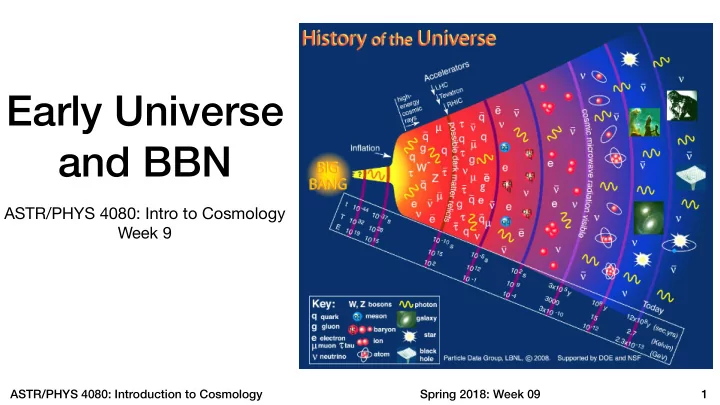

Early Universe and BBN ASTR/PHYS 4080: Intro to Cosmology Week 9 ASTR/PHYS 4080: Introduction to Cosmology Spring 2018: Week 09 1
Early Universe Timescales ASTR/PHYS 4080: Introduction to Cosmology Spring 2018: Week 09 2
Early Universe Timescales ASTR/PHYS 4080: Introduction to Cosmology Spring 2018: Week 09 3
Early Universe Timescales ASTR/PHYS 4080: Introduction to Cosmology Spring 2018: Week 09 4
Nuclear Binding Energy release energy expect nucleosynthesis to result in all atoms becoming iron does not happen - why not? ASTR/PHYS 4080: Introduction to Cosmology Spring 2018: Week 09 5
neutron-proton ratio ASTR/PHYS 4080: Introduction to Cosmology Spring 2018: Week 09 6
ASIDE: Reionization Signature hydrogen hyperfine transition (electron spin flips) emits photon at 21cm (1.4 GHz) can observe at high (z~10) redshifts https://youtu.be/kifF3RYcfn0 and see the first stars ionizing the neutral gas formed at recombination ASTR/PHYS 4080: Introduction to Cosmology Spring 2018: Week 09 7
ASIDE: Reionization Signature ASTR/PHYS 4080: Introduction to Cosmology Spring 2018: Week 09 8
ASIDE: Reionization Signature ASTR/PHYS 4080: Introduction to Cosmology Spring 2018: Week 09 9
Deuterium Synthesis ASTR/PHYS 4080: Introduction to Cosmology Spring 2018: Week 09 10
Making He after 200s, all non-decayed neutrons could end up in a D nucleus, BUT D reactions can also occur: release energy more likely ASTR/PHYS 4080: Introduction to Cosmology Spring 2018: Week 09 11
Making He Tritium and He-3 quickly interact with other particles to form He-4: release energy Strong force reactions: large cross- sections and fast rates End up with mostly He-4, since it’s so tightly bound ASTR/PHYS 4080: Introduction to Cosmology Spring 2018: Week 09 12
Making He Can’t add p or n to He-4 to make a new atom, so have to use later products to form Li/Be nuclei release energy no stable nuclei Stable He-4 is made quickly, but harder to form higher A elements so their creation is slower ASTR/PHYS 4080: Introduction to Cosmology Spring 2018: Week 09 13
BBN ASTR/PHYS 4080: Introduction to Cosmology Spring 2018: Week 09 14
BBN ASTR/PHYS 4080: Introduction to Cosmology Spring 2018: Week 09 15
Abundances from Nucleosynthesis Creation process depends on relative abundances at any given time, so have to calculate computationally Nucleosynthesis doesn’t run to completion like in stars — rapidly dropping temperature cuts it off and “freezes” abundance pattern Exact yields depend most on baryon- to-photon ratio: (determines temperature of nucleosynthesis) ASTR/PHYS 4080: Introduction to Cosmology Spring 2018: Week 09 16
Measuring BBN quasar absorption lines CMB ASTR/PHYS 4080: Introduction to Cosmology Spring 2018: Week 09 17
Lithium Problem ASTR/PHYS 4080: Introduction to Cosmology Spring 2018: Week 09 18
Solution? ASTR/PHYS 4080: Introduction to Cosmology Spring 2018: Week 09 19
Baryon-Antibaryon Asymmetry no leftover antimatter from the early universe: Standard Model predicts existence of antimatter equally likely should be 1 quark-antiquark pair for every 2 photons in the early universe when temperature drops, quarks annihilate but are no longer produced —> universe should be entirely photons! must be a small asymmetry! ASTR/PHYS 4080: Introduction to Cosmology Spring 2018: Week 09 20
Recommend
More recommend